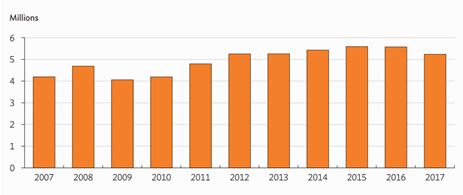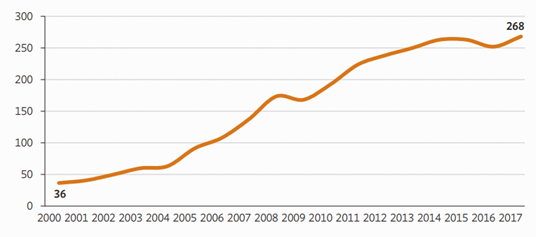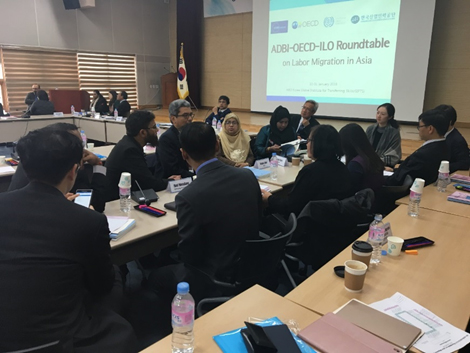
The pace and size of labor migration have been on the rise in past decades, largely due to the different stages of economic development across Asia. Labor migration flows from Asia peaked in 2015 and dropped in the following 2 years, falling to 5.2 million in 2017, the lowest level since 2011. The decrease of about 6% in 2017 reversed the upward trend (Figure 1). Reduced recruitment in the Gulf Cooperation Council countries, the top destinations for Asian workers, was the main reason behind this downward trend (ADBI, OECD, and ILO 2019). The changes in the labor migration trend and its characteristics are described in the recently published ADBI-OECD-ILO migration report [1].
Figure 1: Total Outflows of Workers from Selected Asian Economies, 2007–2017

Note: Total of the 12 economies (Philippines, Bangladesh, People’s Republic of China, Pakistan, India, Nepal, Indonesia, Sri Lanka, Viet Nam, Cambodia, Lao People’s Democratic Republic, and Myanmar).
Source: Data from national authorities.
Regardless of this reversed trend, policy makers should focus on the issues of fair economic benefits and the welfare of migrant workers to deal with any challenges that may arise and ensure effective labor migration management. Asia requires increasingly stronger national and international partnerships to manage labor migration and tackle the associated issues while simultaneously pursuing sustainable development. In fact, as explained in our recent report [1], the contribution of remittances to gross domestic product and the spillover effects for economic and social development in developing Asia are not insubstantial, and overall remittance inflows to the region have increased rapidly since 2000 as shown in Figure 2 (ADBI, OECD, and ILO 2019). Much of these remittances come from income generated by migrant workers who are often in vulnerable employment positions with potentially insufficient protection. How can efficacious partnerships contribute to ensuring the value contribution of labor migration together with the sufficient welfare of migrant workers for sustainable development in Asia?
Figure 2: Remittances to Asia, 2000–2017 ($ billion)

Note: The data for 2017 are estimates.
Source: World Bank. Migration and Remittances Data.
A corresponding discussion was initiated during the 8th ADBI-OECD-ILO Roundtable on Labor Migration in Asia in Incheon, Republic of Korea [2], during 30–31 January 2018. The roundtable was themed “Building partnerships for effectively managing labor migration: Lessons from Asian countries for the UN Global Compact on Migration”. The Human Resources Development Service of Korea (HRD Korea) hosted the roundtable, and its work was one of the highlights of Session 3. HRD Korea’s experts explained the benefits of the Republic of Korea’s Employment Permit System, a government-to-government arrangement for managing labor migration flows to reduce transaction costs as well as human rights abuses against migrant workers caused by illegal labor brokers. In addition, Session 4 contributed to the discussion on the social protection of migrant workers by using bilateral and multilateral mechanisms developed within and outside the region to ensure the portability of social security. Session 6 focused on the electronics sector to examine the importance of partnerships among governments, businesses, international organizations, and civil society organizations to protect migrant workers’ rights and welfare.
8th ADBI-OECD-ILO Roundtable on Labor Migration in Asia (30–31 January 2019, Incheon, Republic of Korea)

As an output of the labor migration roundtable, ADBI, the Organisation for Economic Co-operation and Development (OECD), and the International Labour Organization (ILO) have recently published an annual publication titled, “Building Partnerships for Effectively Managing Labor Migration: Lessons from Asian Countries [1]”. This book integrates and expands on the fruitful discussions during the roundtable and is intended to give policy makers ideas to promote comprehensive and inclusive partnerships with innovative approaches for the efficacious management of labor migration. The book consists of four chapters: Chapter 1 focuses on labor migration trends and the related statistics on migrants and remittances, while Chapter 2 looks at the innovative policy elements particular to the Republic of Korea’s Employment Permit System. Chapter 3 emphasizes the importance of greater bilateral and multilateral partnerships to ensure the portability of social security for migrant workers. Finally, Chapter 4 empirically illustrates the influence of labor market intermediaries on labor-migration management in the electrical and electronics industry in Malaysia as a country study. The report concludes with a statistical annex providing the most complete comparative data on migration inflows, outflows, and stocks in the region (ADBI, OECD, and ILO 2019).
In collaboration with the OECD and ILO as a co-organizer of the annual roundtable on labor migration in Asia and the co-editor of its associated annual publication, ADBI reaffirms the importance of the strong partnership for the effective management of labor migration in Asia and the Pacific. Most prominently, the lesson learned is that not only governments but also other major stakeholders need to be included in the dialogue and have a shared understanding of the issues to enhance this much-needed partnership. As said by ADBI Deputy Dean Chul Ju Kim during the roundtable, “Coming together is a beginning. Keeping together is progress. Working together is success.” ADBI is committed to being a part of these stronger partnerships and providing a policy platform for Asian policy makers and stakeholders to gather and brainstorm for the effective management of labor migration in the region.
_____
References:
Asian Development Bank Institute (ADBI), Organisation for Economic Co-operation and Development (OECD), and International Labour Organization (ILO). 2019. Building Partnerships for Effectively Managing Labor Migration: Lessons from Asian Countries [1].
World Bank. Migration and Remittances Data [3]. Bilateral Remittance Matrix (accessed November 2018).